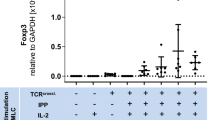Summary
Recently we described a cutaneous T-cell lymphoma expressing the γ/δ T-cell receptor [5]. The patient suffering from this lymphoma showed low numbers of myeloid and T cells in peripheral blood, while B and NK cells were relatively increased. In vitro culture of the patient's bone marrow (BM) cells revealed a significant suppression of myeloid/monocyte colony formation (GM-CFU) compared with normal controls. This was not due to infiltration of the BM with lymphoma cells. We speculated that a soluble factor either secreted or induced by the lymphoma cells might be responsible for the marked suppression of hematopoiesis in this patient. From a skin biopsy with infiltrating γ/δ T-lymphoma cells we established T-cell clones bearing the γ/δ T-cell receptor and resembling the phenotype of the lymphoma cells. The supernatant (SN) of these γ/δ T-cell clones reduced the number of colonies in a CFU-GM assay (using normal control BM) in comparison to SN of α/β T-cell clones established from the same biopsy. This suppression was seen mainly on day 7 of culture and was not neutralized by the addition of placenta-CM. The main mediator of this suppression seems to be IFN-γ,since it was detectable in high amounts in the SN of these γ/δ T-cell tumor clones as well as in the serum of the patient. In addition, anti-IFN-γ antibodies can reverse the T-cell SN-mediated suppression of CFU-GM. We conclude that high serum levels of interferon-γ, which is secreted in high amounts from γ/δ T-cells grown from a biopsy of a cutaneous lymphoma, can suppress hematopoiesis.
Similar content being viewed by others
Abbreviations
- TCR:
-
T-cell receptor
- IFN-γ:
-
interferon-γ
- SN:
-
supernatant
- placenta CM:
-
placenta conditioned medium
- BM:
-
bone marrow
- CFU-GM:
-
myeloid/monocyte colony formation
- NK cells:
-
natural killer cells
- Ab:
-
antibody
References
Barber KE, Crosier PS, Purdie KJ, Buchanan JM, Cattermole JA, Watson JD, Gillis S (1989) Human interleukin 3: effects on normal and leukemic cells. Growth Factors 101–114
Berti E, Cerri A, Cavicchini S, Delia D, Solingo D, Alessi E, Caputo R (1991) Primary cutaneous gamma/delta T-cell lymphoma presenting as disseminated pagetoid reticulosis. J Invest Dermatol 96: 718–723
Boehm T, Baer R, Lavenir I, Forster A, Waters JJ, Nacheva E, Rabbitts TH (1988) The mechanism of chromosomal translocation t(11;14) involving the T-cell receptor C5 locus on human chromosome 14q11 and a transcribed region of chromosome 11p15. EMBO J 7: 385–394
Brenner MB, Strominger JL, Krangel MS (1988) The γ/δ T-cell receptor. Adv Immunol 43: 133–192
Burg G, Dummer R, Wilhelm M, Nestle F, Ott MM, Feller AC, Hefner H, Lanz U, Schwinn A, Wiede J (1991) A subcutaneous delta-positive T-cell lymphoma that produces interferon gamma. N Engl J Med 325: 1078–1081
Christmas SE (1991) Gamma delta T-lymphocyte clonality in pure red blood cell aplasia. Blood 77: 1127
Coutinho LH, Testa NG, Dexter TM (1986) The myelosuppressive effect of recombinant interferon γ in short-term and long-term marrow cultures. Br J Haematol 63: 517–524
Deutsch K, Lüling F, Reich K, Classen M, Wagner H, Pfeffer K (1991) A major fraction of human intraepithelial lymphocytes simultaneously expresses the γ/δ T cell receptor, the CD8 accessory molecule and preferentially uses the Vδ1 gene segment. Eur J Immunol 21: 1053–1059
Dexter TM (1989) Regulation of hemopoietic cell growth and development. Leukemia 3: 469–474
Gajewski TF, Goldwasser E, Fitch FW (1988) Anti-proliferative effect of IFN-γ in immune regulation. J Immunol 141: 2635–2642
Gastl G, Huber C (1988) The biology of interferon actions. Blut 56: 193–199
Groopman JE, Molina JM, Scadden DT (1989) Hematopoietic growth factors. N Engl J Med 321: 1449–1459
Haanen JBAG, Malefijt RdW, Res PCM, Kraakman EM, Ottenhoff THM, de Vries RRP, Spits H (1991) Selection of a T-helper type 1-like T cell subset by mycobacteria. J Exp Med 174: 583–592
Heberman RB (1986) Effects of biological response modifiers on effector cells with cytotoxic activity against tumors. Semin Oncol 13: 195–204
Janeway CA jr (1990) Gamma delta T cells: research on the frontlines of defence. Res Immunol 141: 688–695
Laver J, Malaspina HG, Kernan NA, Levick J, Evans RL, O'Reilly RJ, Moore MAS (1988) In vitro interferon γ production by cultured T-cells in severe aplastic anaemia. Br J Haematol 69: 545–550
Pawelec G, Sayers T, Busch FW (1989) Regulation of normal myelopoiesis and chronic myelogenous leukaemia cell proliferation through a non-cytotoxic mechanism by a γ/δ T cell clone. Immunol Letters 22: 199–204
Pike BL, Robinson WA (1970) Human bone marrow colony growth in agar gel. J Cell Physiol 76: 77–84
Triebel F, Hercend T (1989) Subpopulations of human peripheral T gamma delta lymphocytes. Immunol Today 10: 186–188
Wilhelm M, Tony HP (1990) Characterization of an acute T lymphoblastic leukemia expressing the gamma/delta T-cell receptor. Blut 61: 213–218
Yokota S, Hansen-Hagge TE, Bartram CR (1991) T-cell receptor γ gene recombination in common acute lymphoblastic leukemia: preferential usage of Vδ2 and frequent involvement of the Jα cluster. Blood 77: 141–148
Author information
Authors and Affiliations
Additional information
M. Wilhelm was supported by theDeutsche Forschungsgemeinschaft (DFG Wi 728-2)
Rights and permissions
About this article
Cite this article
Wilhelm, M., Meyer, P., Batram, C. et al. γ/δ Receptor-expressing T-cell clones from a cutaneous T-cell lymphoma suppress hematopoiesis. Ann Hematol 65, 111–115 (1992). https://doi.org/10.1007/BF01695808
Received:
Accepted:
Issue Date:
DOI: https://doi.org/10.1007/BF01695808




